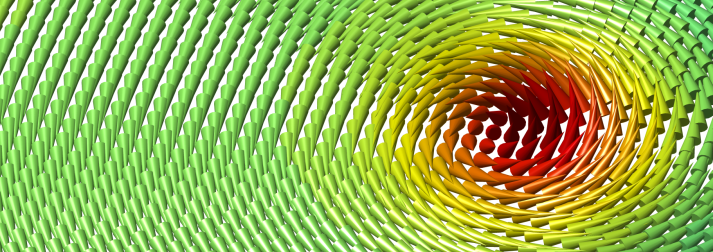Magnetism

Magnonics, 3D magnetic nanostructures by FEBID/FIBID, Metamagnetic (FeRh) nanostructures, Magnetic vortices, Magnetic patterning by direct focused ion beam writing, ...
 |
>>> http://magnetism.ceitec.cz |
|
|
Former members
Viola Křižáková, graduate, now PhD at ETH Zurich in group of Prof. Gambardella
Kateřina Fabianová, graduate, now at Tescan company
Jiří Jaskowiec, graduate, now at Tescan company
Jiří Liška, postdoctoral researcher
Lukáš Flajšman, PhD, now postdoc at Aalto University
Lucie Motyčková, graduate
Magnetic vortices
Magnetic vortices are curling magnetization structures formed in micro- and nanosized magnetic disks and polygons. They are known for having four different magnetization configurations (vortex states) that can be used for a multibit memory cell. We study dynamic magnetization processes of switching of the vortex states and we investigate the possibilities of writing two bits of information into a magnetic vortex.
For further details, contact Michal Urbánek (urbanek(at)fme.vutbr.cz).
- Uhlíř et. al., Nature Nanotechnology 8, 341–346 (2013)
- Vaňatka et al., AIP Advances 7 (10), 105103 (2017)
Magnetic patterning by direct focused ion beam writing
Direct writing of magnetic patterns by focused-ion-beam irradiation presents a favorable alternative to the conventional lithography approaches. We study epitaxially grown metastable face-centered cubic (fcc) Fe thin films which undergo structural (fcc->bcc) and magnetic (paramagnetic->ferromagnetic) phase transformation upon ion-beam-irradiation. By using focused ion beam we were able to write ferromagnetic (bcc Fe) patterns into the paramagnetic (fcc Fe) layer with sub-100 nm resolution. Further, we can tune the spontaneous magnetization by cahnging ion dose and even anisotropy by changing the direction of rastering with focused ion beam.
For further details, contact Michal Urbánek (urbanek(at)fme.vutbr.cz).
